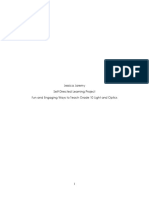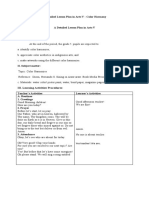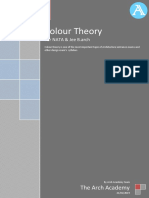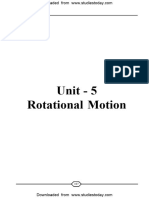2 - PhET Simulation - Color Vision
2 - PhET Simulation - Color Vision
Uploaded by
Ava MittoneCopyright:
Available Formats
2 - PhET Simulation - Color Vision
2 - PhET Simulation - Color Vision
Uploaded by
Ava MittoneOriginal Title
Copyright
Available Formats
Share this document
Did you find this document useful?
Is this content inappropriate?
Copyright:
Available Formats
2 - PhET Simulation - Color Vision
2 - PhET Simulation - Color Vision
Uploaded by
Ava MittoneCopyright:
Available Formats
Physics Name Ava
PhET Simulation – Colour Vision Date 12/06/21
Access: Google “PhET simulations.” Click on Light & Radiation. Launch the Color Vision Simulation.
Part I – Use the RGB Bulbs Tab
1) Each light has a color gradient. For the best results, slide the bar to the very top of each color. Each color should
be observed individually for this first part. To stop the color, return the bar to the black location.
a) What color is seen when the red light is on?
red
b) What color is seen when the green light is on?
green
c) What color is seen when the blue light is on?
blue
2) For the next part we will investigate the effects of mixing two colors. Before you begin each part be sure to make
a hypothesis.
a) What color do you think the man will see when red and green are mixed together?
I think she will see yellow.
b) Turn on the red and green, both to the very top of the color scale. What does the man actually see?
She saw yellow.
c) Experiment with the degree of color. While doing this, make sure that both colors are in equal locations on
the scale. What colors are observed? Do they still fit into the same color family as the color observed in
‘b’?
The other colours that are observed are darker shades of yellow, orange, and dark green. They do fit into the same
colour family as yellow.
3) Keep the red light on (to the top red location), and turn off the green. We will be looking at red and blue next.
a) What color do you think the man will see when red and blue are mixed together?
I think she will see purple
b) Turn on the red and blue, both to the very top of the color scale. What does the man actually see?
She saw neon pink.
c) Experiment with the degree of color. While doing this, make sure that both colors are in equal locations on
the scale. What colors are observed? Do they still fit into the same color family as the color observed in
‘b’?
The colours observed are dark shades of purple and red. These colours do fit into the same colour family as neon
pink.
4) Keep the blue light on (to the top blue location), and turn off the red. We will be looking at green and blue next.
a) What color do you think the man will see when green and blue are mixed together?
Continued on the next page.
I think she will see yellow.
b) Turn on the green and blue, both to the very top of the color scale. What does the man actually see?
She saw a light blue.
c) Experiment with the degree of color. While doing this, make sure that both colors are in equal locations on
the scale. What colors are observed? Do they still fit into the same color family as the color observed in
‘b’?
The colours observed were dark shades of teal and green. These colours do fit into the same colour family as light
blue.
5) Now we will be looking at mixing all three colors.
a. What color do you think the man will see when red, green and blue are all mixed together?
I think she will see brown.
b. Turn on all three colors, all to the very top of the color scale. What does the man actually see?
She saw white.
Part II – Use the Single Bulb Tab
Click on Light & Radiation and use the single bulb for this part of the simulation.
1) Set the simulation to the following: bulb type – ‘white’, beam – ‘photons’, and filter color – ‘off’.
a) What is coming out of the bulb?
Rainbow coloured dots.
b) What color light does the man see?
The man sees white.
2) Set the simulation to the following: bulb type – ‘white’, beam – ‘solid’, and filter color – ‘off’.
a) What is coming out of the bulb?
A white light.
b) What color light does the man see?
3) The man sees white.
4) Set the simulation to the following: bulb type – ‘white’, beam – ‘photons’, and filter color – ‘on’.
a) Choose any filter color. Record the color red.
b) What is coming out of the bulb before the filter (in the area just in front of the filter)?
Rainbow coloured dots.
c) What is coming out after the filter?
Red coloured dots.
d) What color light does the man see?
The man sees red.
e) Choose another filter color. Record the color blue.
f) Repeat questions b-d (above) for this filter. Please record your observations as you answer the questions.
b) rainbow coloured dots.
c) blue coloured dots.
Continued on the next page.
d) the man sees blue.
g) What is the filter doing?
The filter is causing the person to see a certain colour.
5) Set the simulation to the following: bulb type – ‘white’, beam – ‘solid, and filter color – ‘on’.
a) Choose any filter color. Record the color blue. Repeat questions b-d (from question 3
on the last page). Please record your observations as you answer the questions.
b) a white light
c) a blue light
d) the man sees blue.
b) Choose another filter color. Record the color orange. Repeat questions b-d (from question
3 on the last page). Please record your observations as you answer the questions.
b) a white light
c) a orange light
d) the man sees orange.
c) What are the differences between question 3 (photon setting) and question 4 (solid setting)?
The photon settings produced rainbow coloured dots, while the solid setting produced a solid white light.
d) What are the similarities between question 3 (photon setting) and question 4 (solid setting)?
They both make the man see the same colour.
6) Set the simulation to the following: bulb type – ‘monochromatic, beam – ‘solid, and filter color – ‘on’.
a) Select a bulb color and a filter color that are different. Record the colors chosen below. What does the man
see?
Bulb Color: red
Filter Color: blue
Color seen by the man: no colour
b) Select a bulb color and a filter color that are the same. Record the colors chosen below. What does the man
see?
Bulb Color: orange
Filter Color: green
Color seen by the man: no colour
c) What is the filter doing?
The filter is causing the man to see no colours.
Continued on the next page.
You might also like
- TS - JR - Physics Imp - Questions 2022-23 PDF100% (3)TS - JR - Physics Imp - Questions 2022-23 PDF5 pages
- Exercise 3.4 (6.4) T-2 6.4 Colours of LightNo ratings yetExercise 3.4 (6.4) T-2 6.4 Colours of Light3 pages
- Detailed Lesson Plan Grade 4-Sining (1 Quarter)No ratings yetDetailed Lesson Plan Grade 4-Sining (1 Quarter)5 pages
- Jessica Jaremy Self Directed Learning Light and OpticsNo ratings yetJessica Jaremy Self Directed Learning Light and Optics39 pages
- WorkbookEdition 1 The Colors Around You7No ratings yetWorkbookEdition 1 The Colors Around You73 pages
- S2-2nd Edit Unit-6 (6.4 Colours of Light)No ratings yetS2-2nd Edit Unit-6 (6.4 Colours of Light)18 pages
- Gamma Rays Radio Visible Light MicrowavesNo ratings yetGamma Rays Radio Visible Light Microwaves2 pages
- 1C - Family and Friends 1 - STARTER - L2 - Bài tập Bổ trợNo ratings yet1C - Family and Friends 1 - STARTER - L2 - Bài tập Bổ trợ4 pages
- Lesson: Color Theory: The Basics of Color WheelNo ratings yetLesson: Color Theory: The Basics of Color Wheel9 pages
- Form and Colour Composite_FSBC 1109_Set 3_Dec 2023_RGNIYDNo ratings yetForm and Colour Composite_FSBC 1109_Set 3_Dec 2023_RGNIYD3 pages
- P1-F Revision For Midyear - Listening - ColorsNo ratings yetP1-F Revision For Midyear - Listening - Colors4 pages
- Science8 q1 Mod5 Colors-Of-light FINAL07282020No ratings yetScience8 q1 Mod5 Colors-Of-light FINAL0728202018 pages
- MOdelling of Wake-Induced Transition With Dynamic PDFNo ratings yetMOdelling of Wake-Induced Transition With Dynamic PDF163 pages
- EBB 424E Semiconductor Devices and Optoelectronics: Part II - Optoelectronics DR Zainovia LockmanNo ratings yetEBB 424E Semiconductor Devices and Optoelectronics: Part II - Optoelectronics DR Zainovia Lockman50 pages
- Design and Analysis of MIMO Patch Antenna For 5G WNo ratings yetDesign and Analysis of MIMO Patch Antenna For 5G W17 pages
- Class 11 Physics Multiple Choice Questions - MCQs - With Answer On Circular Motion Topic100% (1)Class 11 Physics Multiple Choice Questions - MCQs - With Answer On Circular Motion Topic12 pages
- Breaking Wave Characteristics and Breaking Wave Forces On Slender CylindersNo ratings yetBreaking Wave Characteristics and Breaking Wave Forces On Slender Cylinders324 pages
- Force and Motion Displacement and Distance Practice Problems With Answers PDFNo ratings yetForce and Motion Displacement and Distance Practice Problems With Answers PDF10 pages
- Seismic Characterization Chelyabinsk MeteorNo ratings yetSeismic Characterization Chelyabinsk Meteor6 pages
- Flow Past A Circular Cylinder: William J. Devenport100% (1)Flow Past A Circular Cylinder: William J. Devenport16 pages
- Final Exam - Year 4 - 20MECH28H - Heat Transfer (Final 2021)No ratings yetFinal Exam - Year 4 - 20MECH28H - Heat Transfer (Final 2021)4 pages
- Diffrence Between Phase and Group VelocityNo ratings yetDiffrence Between Phase and Group Velocity1 page
- DHANALAKSHMI SRINIVASAN COLLEGE OF ENGG AND TECHNOLOGYNo ratings yetDHANALAKSHMI SRINIVASAN COLLEGE OF ENGG AND TECHNOLOGY22 pages

























































































